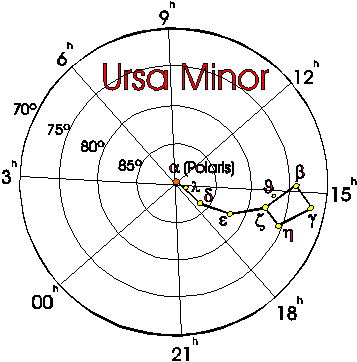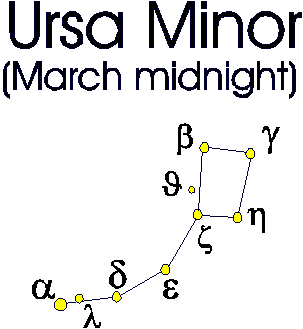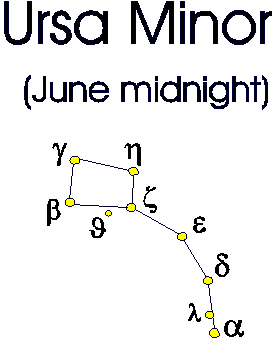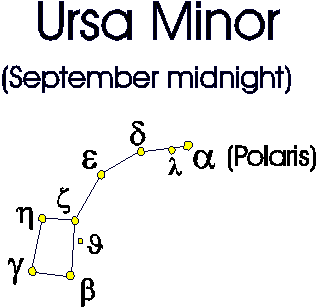
Ursa Minor's only claim to fame is as home of the Pole Star, a claim which it will relinquish in the far future (in 12,000 years a much brighter star, Vega -- alpha Lyrae -- will be the north star). This change of polar stars is due to what is termed 'precession', which is caused by the earth's slight wobble. This spin takes 26,000 years for a full rotation, allowing several stars to take their place as pole star. Of these, Vega is the brightest, while Thuban (alpha Draconis) is another on the list. Indeed, Thuban was quite a recent Pole Star, just 5000 years ago.
All northern constellations appear to revolve about the pole star and the further north the constellation the more noticeable the rotation. Ursa Minor itself spins nightly and its aspect depends very much on what time of the night, as well as what time of the year, one studies the constellation. The aspect presented below is that found around midnight in mid-February. It is important to be accustomed to viewing the constellation at other times of the year.

Alpha Ursae Minoris is much better known as The Pole Star, or Polaris, or simply as 'The North Pole' although this isn't quite accurate. The Celestial North Pole is 45 arcminutes from Polaris, a distance so minute that for all practical purposes Polaris does mark the northern point on the celestial sphere around which all other stars revolve.
Knowing where the celestial north pole is (and whenever we mention 'the celestial north pole' or CNP we really mean Polaris) is very useful as other stars can be more easily found once the pole is spotted. For example, moving north from any other star means drawing an imaginary line from that star to Polaris, so this is obviously a key star to locate.
Most people learn to find the north pole by starting at the Big Dipper and using the 'pointer stars' (alpha UMa and beta UMa) which take the observer right to Polaris. You should be aware that several constellations meet very close to the north pole. By the way, delta UMi is included here, although it is out of this particular FOV.
The three stars that form a triangle are in Cepheus although the brightest of the three is still called 2 Ursae Majoris as it was originally catalogued in that constellation. These three stars are a useful orientation. Having found them, now sweep your glasses counter clockwise, keeping Polaris in view. You should then encounter delta UMi. Now it's a simple starhopping exercise to find the rest of the 'little dipper'. From delta move in an opposite direction from Polaris until delta is at the edge of your glasses. You should have delta and epsilon now. These stars mark the middle portion of the handle. Now move in the same direction that you've been going, and zeta will move into your line of sight along with a number of others. These stars form the bowl of the little dipper -- along with gamma, just below beta. These stars that you've just seen are useful to determine the quality of the night sky. The faintest of these, lambda (in the same FOV as alpha) is 6.3 visual magnitude. If you can see this star with the naked eye you've got a spectacular evening ahead of you!
Conveniently the stars of Ursa Minor have different brightnesses, roughly a magnitude difference, which will allow you to judge just how good the skies are: alpha (2.0), gamma (3.0), epsilon (4.2), eta (5.0), and lambda (6.3). On any night then a quick check of how well you can see these various stars will indicate how successful that evening's observation should be.
Apart from Polaris, the most useful star is beta (2.0), known as ‘Kochab’, which is Hebraic rather than Arabian, meaning the North Star. The reason beta is called the North Star may be due to the fact that three thousand years ago beta Ursae Minoris was closer to the celestial north pole than was Polaris.
Kochab is not only the brightest bowl star, but it shines with a very noticeable orange-metallic colour, making it easy to spot. The quickest way to find Kochab is to first locate Cassiopeia, then move in the opposite direction from the pole star about the same distance to the bright orange star. This will be Kochab, beta UMi.
Binocular Menu - Main Menu
Data Table - Bible Verses

Here are midnight renditions of how Ursa Minor appears in other seasons:


